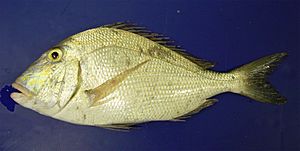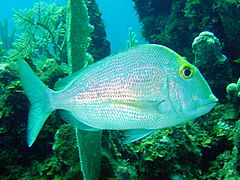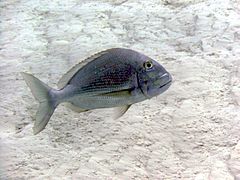Saucereye porgy facts for kids
Quick facts for kids Saucereye porgy |
|
|---|---|
 |
|
| Scientific classification | |
| Synonyms | |
|
The saucereye porgy (Calamus calamus) is a type of fish that lives in the ocean. It belongs to the family called Sparidae. In Bermuda, people sometimes call this fish the goat's head porgy. In Jamaica, it's known as the Porgi grunt or the sugareye porgy. On other Caribbean islands, it might just be called a Porgy. Saucereye porgies are caught for fun by anglers. When caught, they are sold fresh or frozen.
Contents
Discovering the Saucereye Porgy
The saucereye porgy was first described by a French zoologist named Achille Valenciennes. He wrote about it in a large, 22-volume book. This book was called Histoire naturelle des poissons, which means "Natural History of Fishes." He worked on it with another zoologist, Georges Cuvier.
Valenciennes first named this fish Pagellus calamus. He placed it in the genus Pagellus. Later, scientists moved it to the genus Calamus. This name comes from a character in Greek mythology named Calamus. The myth says that Calamus drowned in a river after his friend died. He then turned into aquatic plants. Young saucereye porgies often live in these types of plants.
What Does a Saucereye Porgy Look Like?
Saucereye porgies can grow quite large, up to 56 cm (about 22 inches) long. But usually, they are between 30 to 45 cm (12 to 18 inches) long. Some reports say they can weigh up to 3 lbs. However, the biggest one ever officially recorded weighed 1.5 lbs.
This fish has a blue area on its cheek with yellow spots. It also has a dark blue smudge right behind its upper gill opening.
-
C. calamus in its natural home: A reef near Isla Juventud, Cuba.
-
C. calamus swimming over flat areas in Cozumel, Mexico.
Where Saucereye Porgies Live
Saucereye porgies are only found in the western part of the Atlantic Ocean. They live from North Carolina in the north, east to Bermuda, and south all the way to Brazil. They are most common around the cities of Key West and Havana.
Adult saucereye porgies often live around coral reefs. Divers can easily get close to them there. Younger saucereye porgies prefer to live in beds of sea grass, especially a type called Thalassia.
These fish eat many different kinds of small animals. Their diet includes mollusks, sea worms, brittle stars, hermit crabs, crabs, and sea urchins.
Saucereye Porgies and People
People in the West Indies often eat the saucereye porgy. This is where most of these fish are caught. They are not a huge commercial fish, but they are important to the local economy. Sometimes, eating these fish can make people sick. This can happen during certain times when tiny ocean plants called red tides are present. Saucereye porgies are usually sold fresh or frozen in markets.
See also
 In Spanish: Calamus calamus para niños
In Spanish: Calamus calamus para niños




